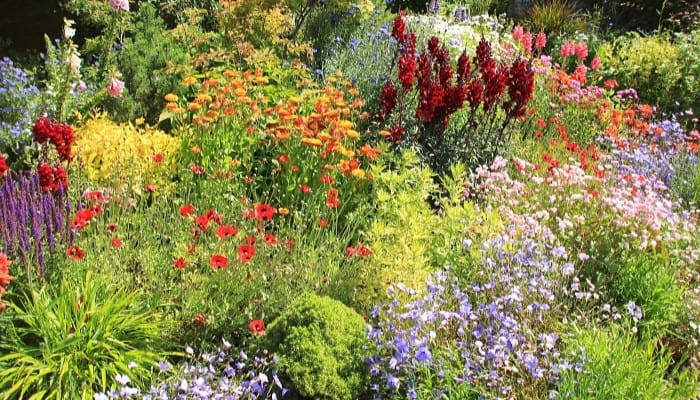Zone 8 is highly sought after by passionate gardeners all over the United States for its welcoming and mild weather conditions.
This warm belt stretches up the western coast of America and along the southern and southeastern border of the country, providing those who live there with long, lazy, hot summers and mild, somewhat balmy winters compared to those living outside this zone.
It’s an excellent zone for passionate gardeners as it provides a long growing season and is the perfect climate to grow beautiful plants and flowers in the garden.
What are the best plants and flowers for growing in zone 8 gardens? Zone 8 is ideal for growing a huge variety of plants, including Hellebores, clematis, mums, coral bells, zinnias, sunflowers, daisies, herbs, nasturtium, pansies, meadowfoam, and many more. Many plants thrive outdoors in this zone due to the average lowest winter temperatures of 10-20℉.
Best Perennial Plants for Growing in Zone 8
Hellebores (Helleborus ‘Ivory Prince’)

Also known as the Christmas rose, it produces large, white bowl-shaped flowers that mature with a rose or pink hue.
It usually blooms in the winter around Christmas time in warmer climates and early spring. Helleborus prefer light or partial shade and thrive in well-draining alkaline soils rich in humus.
- When To Plant: Plant between late autumn and early spring
- Size: It grows to 12-18 inches tall and 18-24 inches wide
- Flowering: Pink buds open to creamy white flowers
- Light Requirements: Full to partial shade
Scilla

Scilla grow from a bulb and produce bell-shaped or star-like flowers. They are delicately scented and bloom in the spring.
Scilla enjoys fertile, well-draining soil and is ideally suited for rock gardens and borders.
- When To Plant: Plant the bulbs in late summer to early autumn for a spring show
- Size: Size may vary depending on the variety; 2 inches to 2 feet tall
- Flowering: Flowers are usually blue but can be pink, white, and purple
- Light Requirements: Full sun to partial shade
Lady’s Slipper Orchid (Cypripedium)
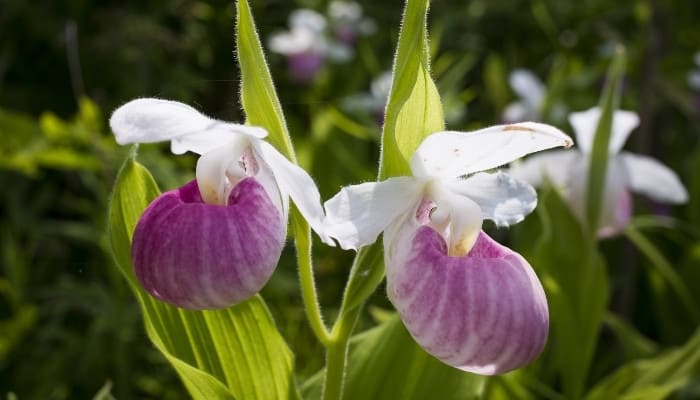
This hardy orchid is much sought after for its striking flowers. Its gorgeous blooms are found in magenta, pink, yellow, and even white, with color combinations and speckling common.
It blooms from mid-spring to early summer and requires dappled light or partial shade conditions to thrive.
- When To Plant: Plant in the early autumn and propagate by division in the early spring
- Size: Can grow between 5 and 6 inches tall
- Flowering: Magenta, pink, yellow, and white, usually in a combination of colors
- Light Requirements: Partial sun with protection from midday rays.
Clematis
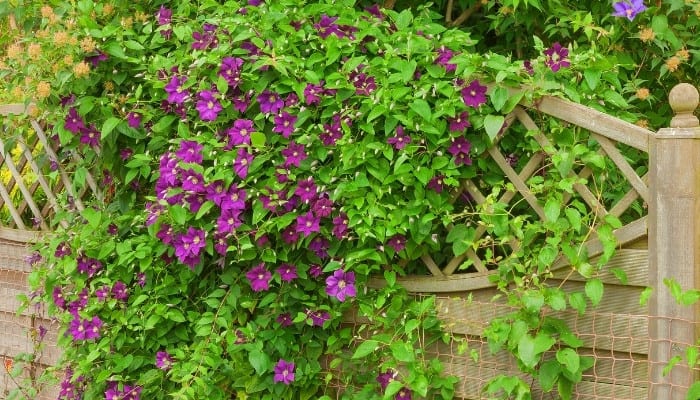
The climbing clematis vine is easy to grow and perfect for outdoor containers and gardens. It thrives in well-drained, moist soil and prefers partial shade.
Keep its foliage in the sun and its roots shaded by smaller plants or pebbles. Prune in the spring and after the first show of flowers in the summer.
- When To Plant: Plant in the autumn or early spring
- Size: Fast-growing, it can achieve heights of 4-5 feet and 1.5-2 feet in width
- Flowering: Blooms in pink, purple, red, white, or yellow depending on variety
- Light Requirements: Tolerant of full sun and prefers afternoon sun in hot climates
Gold and Silver Chrysanthemum (Ajania pacifica)
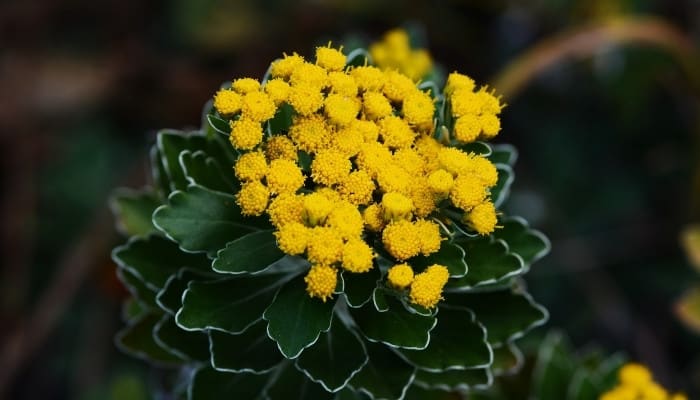
Known for gorgeous green foliage with silvery to white margins, gold-and-silver chrysanthemums are perfectly suited as ground cover and flowers in the autumn producing small, round, yellow buttons of flowers.
It performs well in soils that are moderately fertile and drain well.
- When To Plant: Spring – propagate by division in spring or stem cuttings in summer
- Size: Grows up to 18 inches tall and has a spread of 2-3 feet
- Flowering: Round yellow flowers button flowers
- Light Requirements: Partial sun – requires light afternoon shade
Red Hot Poker (Kniphofia)

The towering Kniphofia has long stems topped with tiny, brilliant orange flame-colored trumpet-like flowers.
These flowers form a tubular shape much like that of a poker head. In addition, the red hot poker is a sun worshiper and thrives in moist, well-drained soil with an acidic or neutral pH.
- When To Plant: Plant seedlings or propagate by division or seed in the spring or autumn
- Size: Average height 3-4 feet, width 2-3 feet
- Flowering: Brilliant orange, red, and yellow flower spikes
- Light Requirements: Full sun all day
Golden Marguerite (Anthemis tinctoria)

This vigorously growing perennial comes in various colors, from light creamy yellow to brilliant canary yellow or white.
Chamomile scented, this plant is perfect for winter borders and is the ideal butterfly magnet.
It requires very little water and maintenance and enjoys acidic or neutral, dry, well-drained soil.
- When To Plant: Plant seedlings or propagate in the spring by division or with seed, alternatively, propagate with basal root cuttings in early summer
- Size: Height 2.5-3 feet tall
- Flowering: Lemon yellow, brilliant yellow, or white
- Light Requirements: Full sun required
Elephant Ears

The giant green elephant-ear-shaped leaves are often grown for their exotic appearance.
To thrive, they require moist organic-rich soil and prefer full to partial sun exposure. These bulb-growing perennials are easy to grow and provide the perfect focal point.
- When To Plant: Plant in the spring to summer after all the late frosts have passed
- Size: Can reach a height of 5-8 feet and a width of 3-6 feet
- Flowering: Large green foliage
- Light Requirements: Full to partial sun required
Dwarf Lady’s Mantle (Alchemilla erythropoda)

The Alchemilla erythropoda produces blue-green leaves with delicate yellow to red flowers in the early summer.
It grows well in moist, well-drained soil and is relatively low maintenance.
Dwarf lady’s mantle is happy to self-seed in good growing conditions. Remove dead heads to prevent further self-seeding as the plant can be invasive.
- When To Plant: Plant in early spring after the last frost
- Size: Height 4-6 inches tall, width 2 feet
- Flowering: Tiny star-like flowers with a greenish-yellow hue developing into a blush red
- Light Requirements: Full to partial sun for healthy growth
Coral Bells
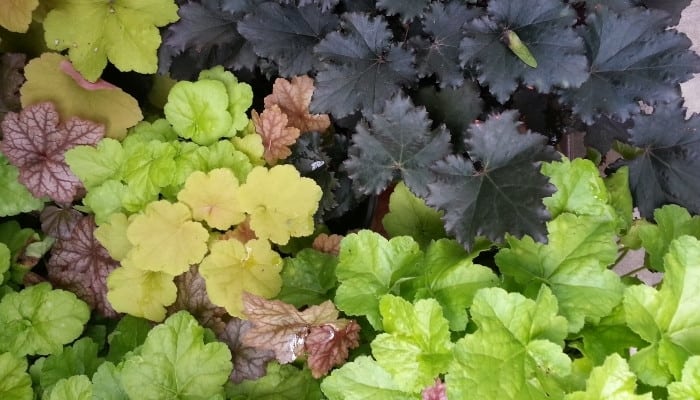
The perfect all-rounder, coral bells do well as ground cover, as edging, or in rockeries.
Its gorgeous star-shaped leaves are multi-colored in shades of dark green and purple-bronze. It enjoys moist, well-drained soil and prefers a medium dry, shady environment.
- When To Plant: Plant all year round as the plant is frost and heat hardy
- Size: Forms basal mounds of between 7 and 12 inches tall with a width of 14 -16 inches
- Flowering: Produces small off-white bell-shaped flowers on deep red stems from late spring to mid-summer
- Light Requirements: Partial shade as full sun causes leaf scorch
Bear’s Breech (Acanthus mollis)
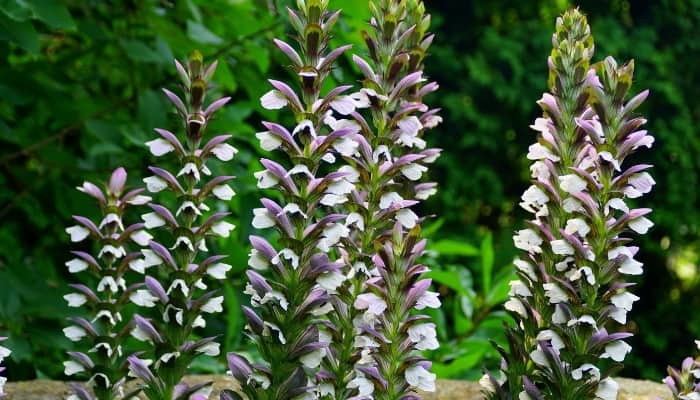
The Acanthus boasts gorgeous deep green leaves, and in the summer, it produces a tall flower with pink/purple and cream flowers.
This plant is super easy to grow and requires minimal care. Its growth rate is fast, and it enjoys full or partial sun with moist, well-draining, fertile soil.
- When To Plant: Plant in the spring or autumn
- Size: Height 2-4 feet and 2-3 feet wide – develops into a large plant due to aggressive growth
- Flowering: Large erect flower stem with pink/purple and white funnel flowers
- Light Requirements: Full sun to part shade. Increased sun exposure increases flowering
Best Annual Plants for Growing in Zone 8
English Daisy (Bellis perennis)
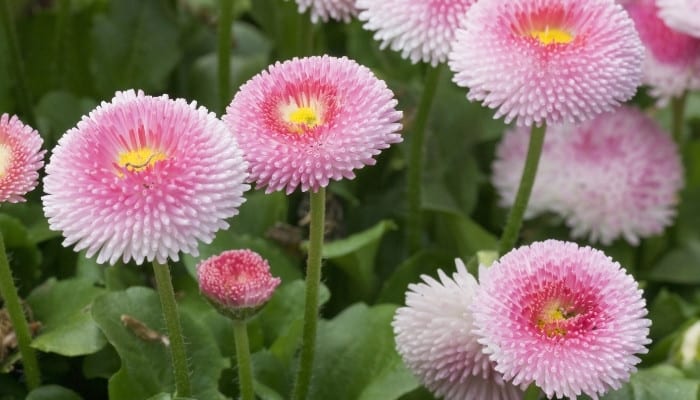
This cute annual produces a multitude of either classic daisy-like blooms or pom-pom-like flowers in shades of pink, red, and white, depending on the variety.
It can be planted in the spring and continues to flower well into the early summer. It thrives in moist, fertile, well-draining soil.
- When To Plant: Plant seeds mid to late spring
- Size: Medium height of 3-6 inches, spread per plant is up to 5-8 inches
- Flowering: Pom-pom flowers in shades of pink, red and white or classic white daisies
- Light Requirements: Partial shade to full sun
Love-Lies-Bleeding (Amaranthus caudatus)

Also known as cat tail and lady’s riding whip, its striking long tassel-like tails are made up of minute red or purple flowers.
The brilliant green foliage creates a contrasting background accented by the exotic flowers.
it is drought and poor soil tolerant but requires copious amounts of water in the heat of summer if soil quality is substandard.
- When To Plant: Plant seeds after the last frosts in mid-spring
- Size: Grows to a height of 3-8 feet and a width of 1-3 feet
- Flowering: Long tails of minute, deep red, or purple flowers
- Light Requirements: Full sun but requires some afternoon shade in hot climates
Mexican Prickly Poppy (Argemone mexicana)
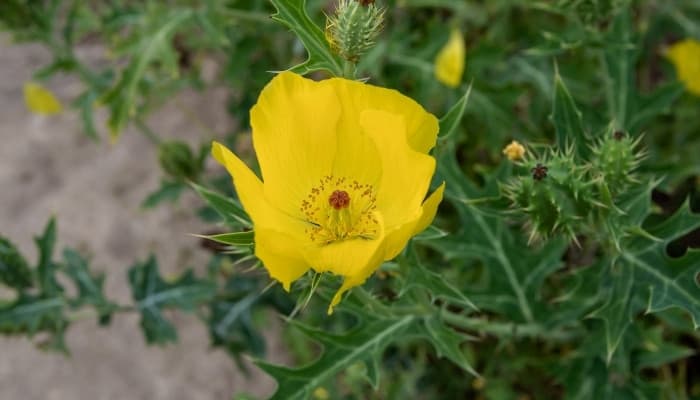
This upright annual sports a prickly blue-green foliage with brilliant yellow or purple flowers similar to that of the poppy.
It blooms from mid-spring to early summer, its colorful flowers creating a lovely splash of color in the garden. Grow in light, well-drained soil with access to loads of sun.
- When To Plant: Plant seeds in the early spring
- Size: Average height is 7-18 inches with 4 inch spread
- Flowering: Bright yellow poppy-like flowers atop spiny stems
- Light Requirements: Bright full sun
Scarlet Pimpernel (Anagallis arvensis)

Low-growing, the Anagallis arvensis has small green leaves with bright rusty-orange flowers. It flowers from spring right through to autumn.
It thrives in most soil types as long as it drains well. It’s pretty low maintenance with low watering requirements.
- When To Plant: Plant seeds in mid-spring after the last frosts
- Size: Height 7-10 inches 1-2 foot spread
- Flowering: Small rusty-orange flowers with round petals
- Light Requirements: Full sun all day
Zinnia
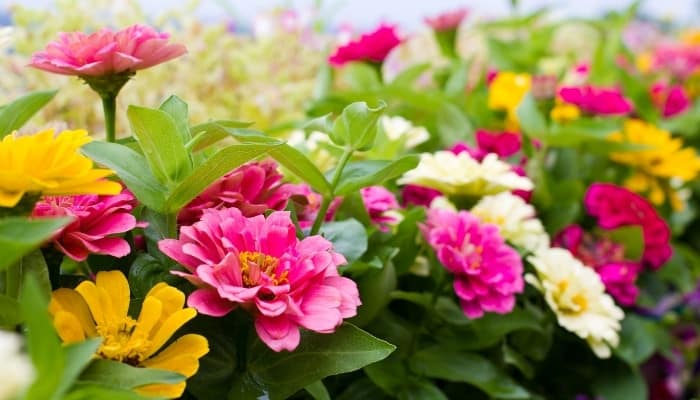
The colorful flowers of zinnia are a perfect addition to sunny garden borders. They bloom from early summer well into the autumn.
This annual is easy to grow and grows well in fertile, moist, well-draining soils.
- When To Plant: Plant seeds mid-spring
- Size: Average height is 14-20 inches tall and 1-2 inches wide
- Flowering: Wide range of cheerful colors
- Light Requirements: Thrives in full sun
Summer Savory (Satureja hortensis)

The Satuerja hortenis is an aromatic brush-like annual. Its foliage is narrow and prickly and grows in spear-shaped spines.
Its leaves can be used to give food a thyme-like taste. It produces tiny white or light-purple flowers and grows best in chalky or sandy conditions.
- When To Plant: Plant seeds in the spring
- Size: Height 10-18 inches and 11-12 inch spread
- Flowering: Tiny white or purple flowers
- Light Requirements: Grows best in full sun
Nasturtium (Tropaeolum majus)
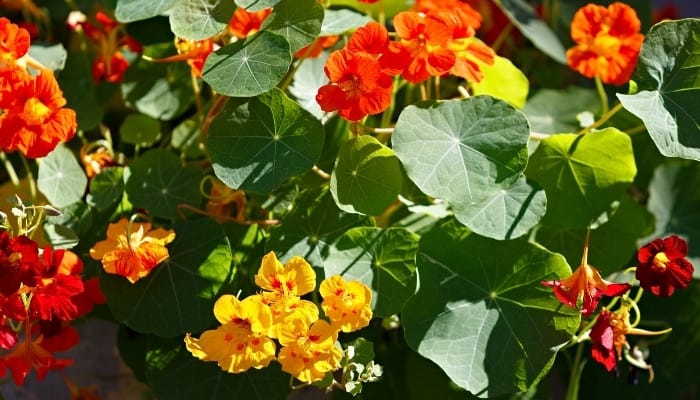
This low fast-growing annual provides bright blooms from early summer right up to the first frosts of late autumn.
They are low maintenance and very easy to grow. They love loamy or sandy soil and cool to moderately warm temperatures.
- When To Plant: Plant seeds in the late spring after the frosts
- Size: 12-18 inches tall with a 1-10 foot spread
- Flowering: Many color variations include orange, red, yellow, and white
- Light Requirements: Part shade or full sun
Common Sunflower (Helianthus annuus)
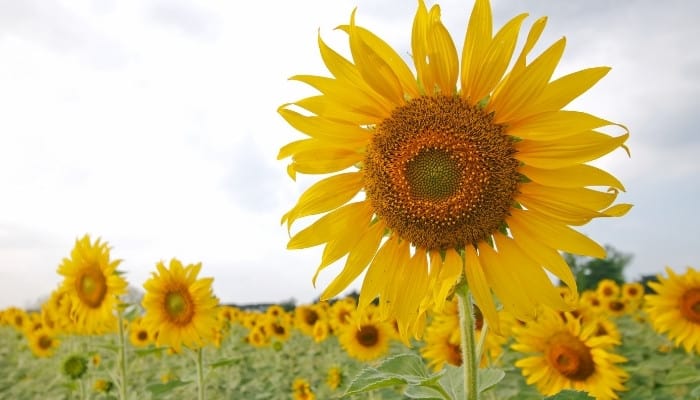
Fast glowing and multicolored, the Helianthus annuus produces large flowers mid to late summer. It thrives in a sheltered location with additional support for its heavy blooms.
This plant enjoys fertile, moist, humus-rich soils.
- When To Plant: Plant in the late spring when temperatures have increased to 55℉
- Size: Average height is 5-6 feet tall
- Flowering: Large multicolored blooms of rose, light pink, orange, and lemon yellow
- Light Requirements: Full sun sheltered from the wind
Field Pansy (Viola bicolor)
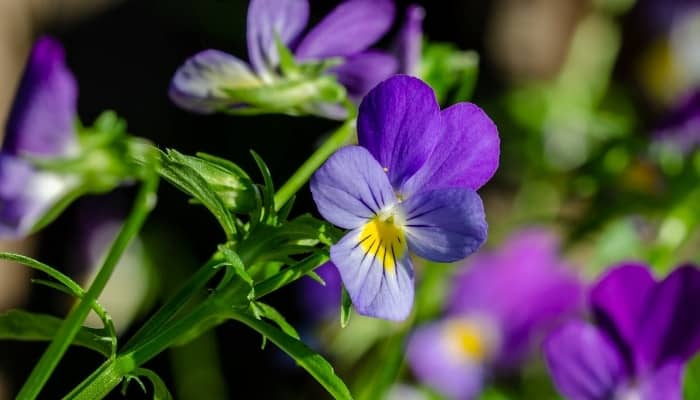
The field or wild pansy grows close to the soil producing deep to soft purple-lilac flowers. It flowers in early spring. It propagates in two ways: by seed and with its creeping roots.
The Viola prefers loamy or sandy soils that have good drainage.
- When To Plant: Propagate using seeds in the early spring
- Size: 1-6 inches in height – spreads easily
- Flowering: Two-tone deep purple and lilac blossoms
- Light Requirements: Full sun to partial shade
Common Madia (Madia elegans)
The Madia elegans provides masses of bright yellow daisy-type flowers. It flowers mid-summer to autumn.
They grow well in clay, sand, and loamy soils that provide good drainage. They have low watering and maintenance requirements and are easy to grow.
- When To Plant: Plant directly in the soil mid-spring
- Size: Grows to 2-4 feet tall and 1-2 feet wide
- Flowering: Brilliant yellow blossoms
- Light Requirements: Prefers full to partial sun
Meadowfoam (Limanthes douglasii)

This low maintenance, bushy annual is fast-growing, sporting yellow and white flowers.
Commonly called the poached egg plant, it quickly spreads like a carpet along borders or pathway edgings.
It blooms throughout the summer and is very easy to grow. It thrives in slightly acidic, moist soil types.
- When To Plant: Propagate in spring or autumn with seed. Protect autumn seed from frost
- Size: Average height is 5-12 inches tall
- Flowering: Cup-shaped yellow and white flowers
- Light Requirements: Thrives in bright sunny conditions
Conclusion
Zone 8 provides the perfect growing conditions for perennials and annuals alike. Its warm temperate climate is literally the avid gardener’s paradise.
Many of the plants we have listed are pretty hardy and well suited to the warm and sometimes cool conditions attributed to Zone 8. Most of these plants thrive in full sun.
However, a few may require a little shade and some extra care, but with careful placement and a relatively low amount of maintenance, gardeners living in Zone 8 can appreciate a garden filled with colorful, vibrant plants and flowers the whole year round.

